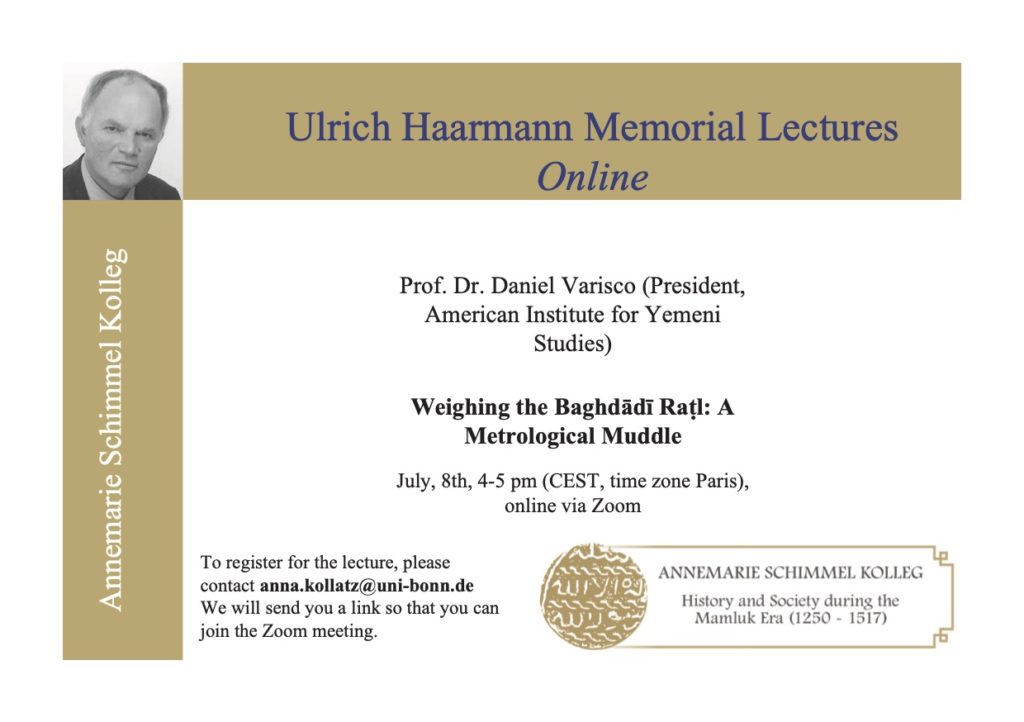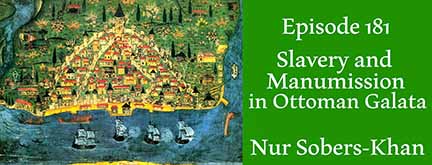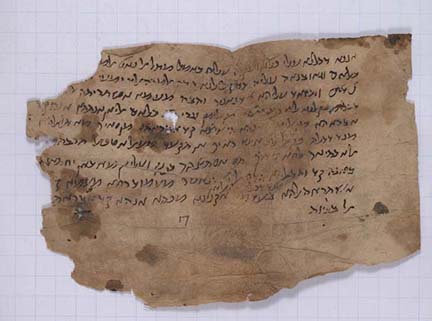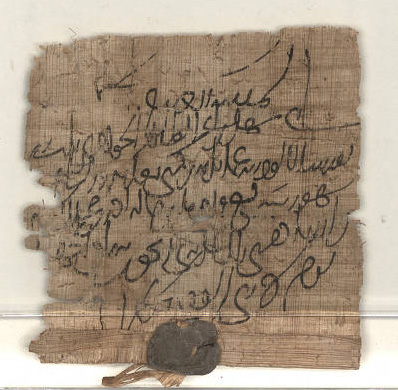
This is a great idea. Back to the human roots of agriculture…
Read about it here.
On Thursday, July 8 , 2021 (4 pm Berlin time, 10 am New York time) I will be giving an online presentation on my search for the metric weight of the Baghdadi ratl, the most widespread measure for international trade in the Red Sea/Indian Ocean network during the Abbasid and Mamluk/Rasulid eras. Although several Western scholars since the mid-19th century have suggested the metric measure of the dirham, a basic unit of the ratl, there is disagreement. Most of the research has focused on the numismatic use of weights with much less on use in the market. Western scholars have ignored the Islamic legal interpretation of two measures used by the Prophet Muhammad (the sa‘ and mudd), which were later interpreted by Muslim religious scholars according to the Baghdadi ratl for zakat and alms. My talk is more of a prolegomena to future study of Islamic metrology than a definitive rendering. I would be pleased to send a copy for comments to anyone interested.


Economy and Material Culture in the Early Islamic Empire
Bi-Weekly, Wednesday, 4-6 pm CEST Starting April 6, 2016
Islamic Material Culture
The Universität Bonn (Bethany Walker), the Ludwig-Maximilians-Universität in Munich (Andreas Kaplony), The Bard Graduate Center in New York (Abigail Balbale), and Universität Hamburg (Stefan Heidemann) are co-operating in setting up a series of webinars in Archaeology of the Middle East, Arabic Papyrology, Islamic Arts and material Culture, and Numismatics of the Middle East.
Why Agriculture?
Why agriculture and the Early Islamic Empire in material culture? Not least Bulliet’s book about the cotton boom (2009) in the Early Empire has stimulated discourse about agriculture and elite culture of the Early Islamic Empire. The webinar tutorial explores different aspects of this agriculture boom in case studies from Central Asia to the Iberian Peninsula. We see a continuation and improvement in efficiency of established forms of irrigation from Late Antiquity to the Early Islamic Empire. The new Muslim elites turned into a landholding class establishing estates and luxurious mansions. The new imperial metropolises created an unprecedented demand in foodstuffs, which was answered by bringnig more land under cultivation and introducing more efficient ways of production. Food had to be transported, and maritime and river routes were established. While some of these developments can be explored through text, material culture and archaeology allows new ways to see this boom in detail. Guest lecturers will include Corisande Fenwick (University College London), Abigale Balbale (The Bard Graduate Center, New York), Sören Stark, Institute for the Study of the Ancient World), and Kristoffer Damgaard (Carsten Niebuhr Institute, Copenhagen), and Bethany Walker (Universität Bonn).
The webinar is part of the ‘Webinar Initiative in Islamic Material Culture’ jointly organized by the Bard Graduate Center, New York, Universität Bonn, Ludwig-Maximilians-Universität, Munich, and Universität Hamburg.
Prerequisites for participation
Spoken and written proficiency in English language. The course is open to all advanced students in B.A., M.A., and PhD programs of Islamic studies, historians, art historians, and archaeologists of the Middle East. All students need a computer, a reliable internet connection, and a headset. In a personal online short skype interview in early April 2016, we will check whether all technical assets are working. Students from Hamburg have to sign up in the campus system ‘Stine’ and to contact Stefan Heidemann as early as possible to register and get the necessary introduction to the technology. Students from universities other than Universität Hamburg are welcome and have to apply with a short CV and a motivation letter in English until March, 15, 2016. These will be emailed to Prof. Stefan Heidemann at: stefan.heidemann@uni-hamburg.de. Preference is given to students from universities within the network of the webinar initiative “Islamic Material Culture”.
http://www.aai.uni-hamburg.de/voror/Personal/agricultural-empire-sommer-2016.html

Andreas Kaplony, H-Mideast-Medieval, Saturday, January 2, 2016
The Arabic Papyrology Database (APD) team wishes you a happy New Year. Our present: new, handy features implemented in the APD and many, many more documents . Please, check www.naher-osten.lmu.de/apd under
(a) “Documents”. For 2,571 published documents, we provide the full text of the document and information on the document, while for another 6,281 published and unpublished documents, we give information on the document only. We are proud to offer not only records from Egypt and the Middle East, but also a quite comprehensive list of Arabic documents from Sicily and Spain: click on “Origin” and choose Sicily or Spain. Weekly updates! – For full bibliographical details, check at www.naher-osten.uni-muenchen.de/apb.
(b) “Text”: This is our full text search tool. Many features, including search restricted by time, provenance, document type, etc.
(c) “Lexicon”: This site is completely new and allows you to access the lexicon of all implemented texts in several ways: Looking for a lemma, you will have an overview on all actual realizations, with hyperlinks giving you direct access. You might look for a root, a verbal stem, or a shape/morpheme type (e.g. fÄÊ¿il or faÊ¿Ê¿Äl). Or try Word categories (functional categories) and Domains (semantic categories), independently or in combined searches.
We would be happy to have your feedback on the new features.
Best regards, Eva Youssef-Grob (evamira.youssef@uzh.ch), for the Arabic Papyrology Database team

Check out the new podcast by Nur Sobers-Khan on the Ottoman History Podcast Site. Here is a description of the podcast:
The legal and social environments surrounding slavery and manumission during the early modern period varied from place to place and profession to profession. In this episode, Nur Sobers-Khan presents her exciting research on the lives of a particular population of slaves in Ottoman Galata during the late eighteenth century, how they were classified and documented under Ottoman law, and the terms by which they were able to achieve their freedom.

The Princeton Geniza Project of the Department of Near Eastern Studies at Princeton University seeks to extend the methodologies available to Hebrew and Arabic scholars working with the documents found in the Geniza chamber of the Ben Ezra Synagogue in Cairo in the late 19th century. The project is dedicated to transcribing documents from film copies to computer files, creating a full text retrieval text-base of transcribed documents, developing new tools such as dictionaries, semantic categories and morphological aids to further the study of Geniza texts. The project is committed to disseminating its materials as widely as possible to the international community of scholars with an interest in the life of the medieval Middle East, as well as to all with an interest in Judaica. It is our hope that by making materials from this very esoteric field widely available that new insights can be gained into the interaction of the peoples of the Middle East in past time. Since inception in 1986, funding has been provided by Princeton University, the Department of Near Eastern Studies, and from 2000 to 2005 by the Friedberg Genizah Project.

Arabic Papyrus #1564: Receipt for agricultural tax (1/3 of a dinar: from Ushmunayn in Middle Egypt. Compete scroll with seal in fine quality light brown papyrus. 9.3 x 8.3 cm written in black ink. Recto: 6 lines. In good condition. Verso: Two lines occupying the middle of the scroll. In good condition. 249 AH/863-4 CE
The Arabic Papyrus, Parchment & Paper Collection at the J. Willard Marriott Library, University of Utah is the largest of its kind in the United States. It contains 770 Arabic documents on papyrus and more than 1300 Arabic documents on paper, as well as several pieces on parchment.
Professor Aziz Suriyal Atiya, founder of the Middle East Center and the Middle East Library, compiled the collection. Dr. Atiya and his wife, Lola, purchased the collection over a period of several years from dealers in Egypt, Beirut, and London. The bulk of the collection originated in Egypt, in addition to a small group of fragments from the University of Chicago. A large number of pieces date to the period between 700 and 850 CE. The collection includes a significant number of documents from the pre-Ottoman period and thus offers unique source material on the political, economic, religious and intellectual life of Egypt during the first two centuries of Islamic rule and the period up to Ottoman domination.